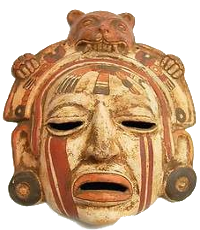Kivas of Chaco Canyon
A kiva is a pit in the ground constructed by the peoples of the Pueblo culture living in today’s southwestern parts of the United States. The kivas were used for living in, for various social purposes, but above all for religious ceremonies. There are kivas of different sizes. Most are only big enough to fit one person but some are enormous. In Chaco Canyon, in today’s New Mexico, there is a kiva which is as big as any mosque or temple elsewhere in the world. It was the largest building in North America until the nineteenth-century.
Chako Canyon was the center of the Pueblo culture and hundreds of buildings were constructed here between 900 and 1150 CE, organized into 15 major complexes. Pueblo Bonito is the most studied. In addition to its great kiva, it contained a structure in four stories which had as many as 650 rooms. There were many smaller houses too which all faced a common plaza. In addition there were many smaller kivas – roughly one for every 29 rooms. And yet the resident population at Chako Canyon seems to have been quite low. Instead people traveled here from outlying villages in order to participate in annual ceremonial occasions.
Why Chaco Canyon was abandoned we do not know, but it is easy to suspect environmental changes, possibly drought. Members of the indigenous Hopi nation, who now live in Arizona, are still telling stories of their migration from Chaco Canyon. In fact, the Hopi are still using kivas in their ceremonies. During the eight days of the annual Wuwuchim festival the rituals are all performed in kivas. They are said to represent the world below from whence human beings emerged. They are also symbolic of the womb.
In 1680 the Pueblo people joined together to fight incursions by the Spanish. Uniting around their shared religion, they pushed both conquistadors and missionaries out of their land for some twenty years. The Spaniards eventually returned, but never to the land of the Hopi. Indeed, the Hopi retain a high degree of self-governance to this day. Today the Pueblo peoples are heavily dependent on royalties from the extraction of natural resources, in particular of coal. The Hopi have repeatedly voted against casinos, but in 2017 they concluded an agreement with the state of Arizona which will allow gambling to take place on their reservation.
External links:
- A Push to Move the Golf Course Atop a Native American ‘Stonehenge’
- Chaco Research Archive
- Charles C. Mann, 1491, The Atlantic, 2002
- National Park Service, “Chaco Culture: The Center of an Ancient World”
- National Park Service, Chako Culture National Historical Park
- Owlcation, “Ancient Hopi Rituals and Ceremonies”
- Science News, “Chaco Canyon’s ancient civilization continues to puzzle”
- Solstice Project
- The Guardian, "'This is our land': New Mexico's tribal groups gear up to fight for their home"
- The Mysteries of Chaco Canyon
- The sundagger explorer
- YouTube, “Perfect kiva cistern”

